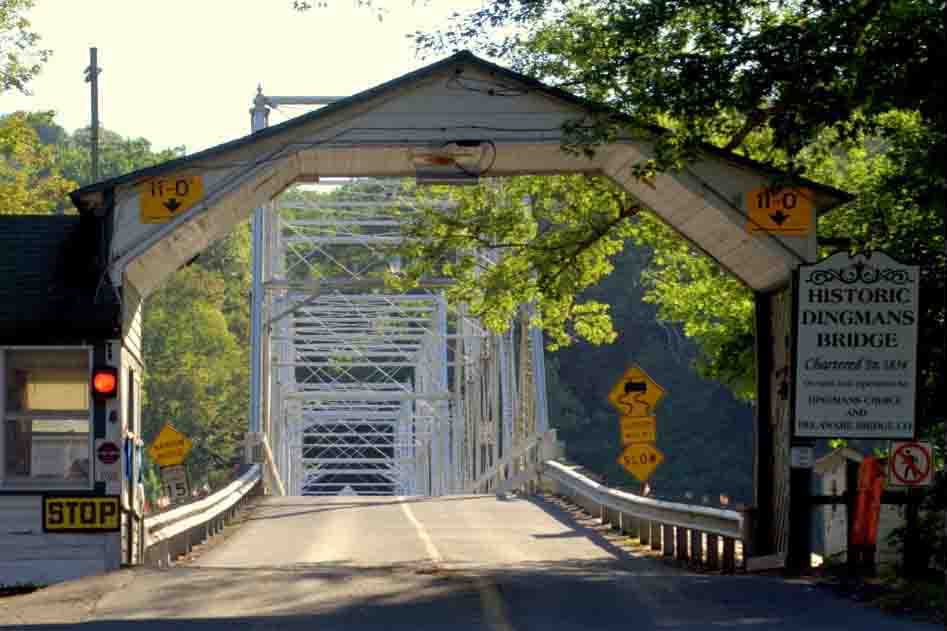
Dingmans Ferry Bridge




The Bridge at Dingmans Ferry traces its roots to the mid 18th century. In 1735, in the Upper Delaware River Valley, the river marked the western frontier of the American Colonies. Andrew Dingman, a Dutchman from Kinderhook, NY, was among the first Europeans to settle in the area along the western bank of the Delaware River near what is now Dingmans Falls. By 1740, several grist mills and sawmills had sprung along Dingmans Creek. Andrew Dingman had constructed a flat boat ferry and was operating a ferry service joining the Old Mine Road (See the Old Mine Road (Wikipedia))in New Jersey to Bethany Pike, which is now Route 739, in Pennsylvania. Prior to the arrival of the Europeans, the area was inhabited by the Lenape Indians. Initial relations between the Native Americans and the European settlers were cooperative and peaceful but the infamous Walking Purchase of 1737 Purchase (See Walking Purchase PHMC) displaced the Lenape and a period of violence ensued. Many settlements along the Delaware were attacked. Andrew Dingman's son, Isaac was shot and killed in 1771. The Lenape sided with the French in the French and Indian Wars. Eventually the Lenape were driven into the Susquehanna Valley and beyond. Today they are in Oklahoma and Ontario Canada. Lenape (Wikipedia)
The ferry service thrived as the American Colonies pushed westward. In response to the demand, the Dingmans
incorporated the Dingmans
Choice and Delaware Bridge Company and received a charter from Pennsylvania and New Jersey in 1834 to
build a bridge at the site.
In 1836, the first bridge was erected by Andrew Dingman's descendents, either his
grandson Daniel W. Dingman or Daniel's son Andrew
Dingman III. That first bridge, likely a wooden covered bridge typical of the Middle
and Upper Delaware, survived the flood of 1841 which
destroyed the downstream bridges at Reiglesville, Centre Bridge, New Hope, Taylorsville, and Yardleyville.
However in 1847, high waters washed the bridge at Milford downstream into the Dingmans Bridge and
carried both bridges into the raging river. The ferry service was restored while a new bridge was
constructed. Completed around
1850, also likely a wooden covered bridge, it was destroyed by wind four or five years later.
A third bridge was hastily erected but it too had a short life.


on the ferry circa 1890s
From 1860 until 1875, Andrew Dingman III operated the ferry. In 1875, John W. Kilsby Sr., who had married Andrew's daughter Mary in 1863, took over the ferry operations. John Kilsby Jr. (Uncle Johnny) was still collecting tolls around 1917.
Around 1890, Dr. James N. Miller, a Layton physician, members of the Dingman family, and several other local residents attempted to raise additional capital to construct a new bridge. They were unable to cultivate enough interest so the ferry continued to be the only means of crossing the river. Dr. Miller, who had a medical practice that spanned the river, is said to have used the ferry cables to suspend himself in a basket to cross the river in high waters or when he couldn't afford to wait for the ferry.
In the spring of 1899, three brothers, E.A. Perkins, James S. Perkins, and William L. Perkins,
The Perkins Brothers had salvaged a bridge across the Susquehanna near Muncy, Pa. They brought three
trusses manufactured by the
Phoenix Iron Works
and the capital to fund the construction.


A letter dated November 28th, 1900 from EA Perkins to the local toll collector, acknowledges receipt of "a little over $300" for the 1st quarter of operation.
EA Perkins served as president of the reorgnaized company until his death in 1930. Today, descendents of his siblings continue to hold the majority interest in the company and to serve as corporate officers.
In 1955 Hurricane Connie and Diane dealt a one two punch to the Delaware River Valley sending flood waters
nearly to the deck of the bridge.
But Mother Nature's fury wasn' t the only blow to the communities along the Delaware.

In 1968, at least in part in response to the December 1967 collapse of the Silver Bridge across the Ohio River, Congress added a section to the Federal Highway Act of 1968 requiring the Secretary of Transportation to establish a National Bridge Inspection Standard (NBIS). The initial standard was applied to bridges on Federal Highway Aid programs but by 1978 the rules were extended to bridges on all public highways. In 1979, to comply with the NBIS, the Dingmans Bridge Company began a fruitful thirty-three year (and still counting) relationship with Hartman Engineering to provide inspection and engineering services. To this day, for two weeks in early June, an inspection team from Hartman Engineering performs an element level inspection (well in excess of the requirements of NBIS) and each September local contractors complete necessary repairs and routine maintenance. No public funds have ever been used to complete any of the inspection or maintenance program.

